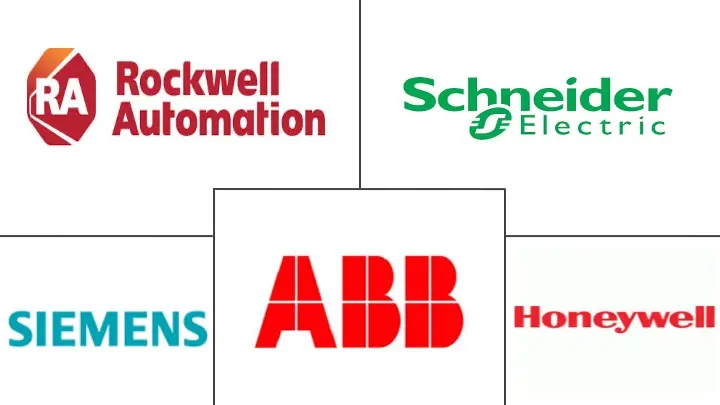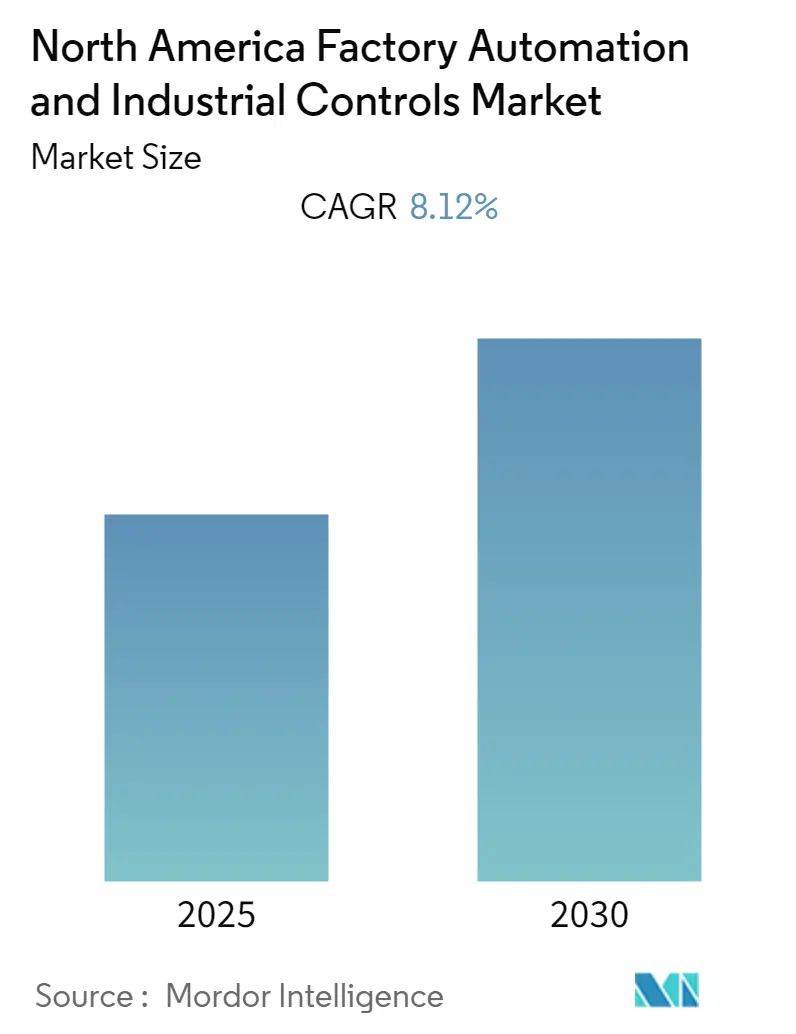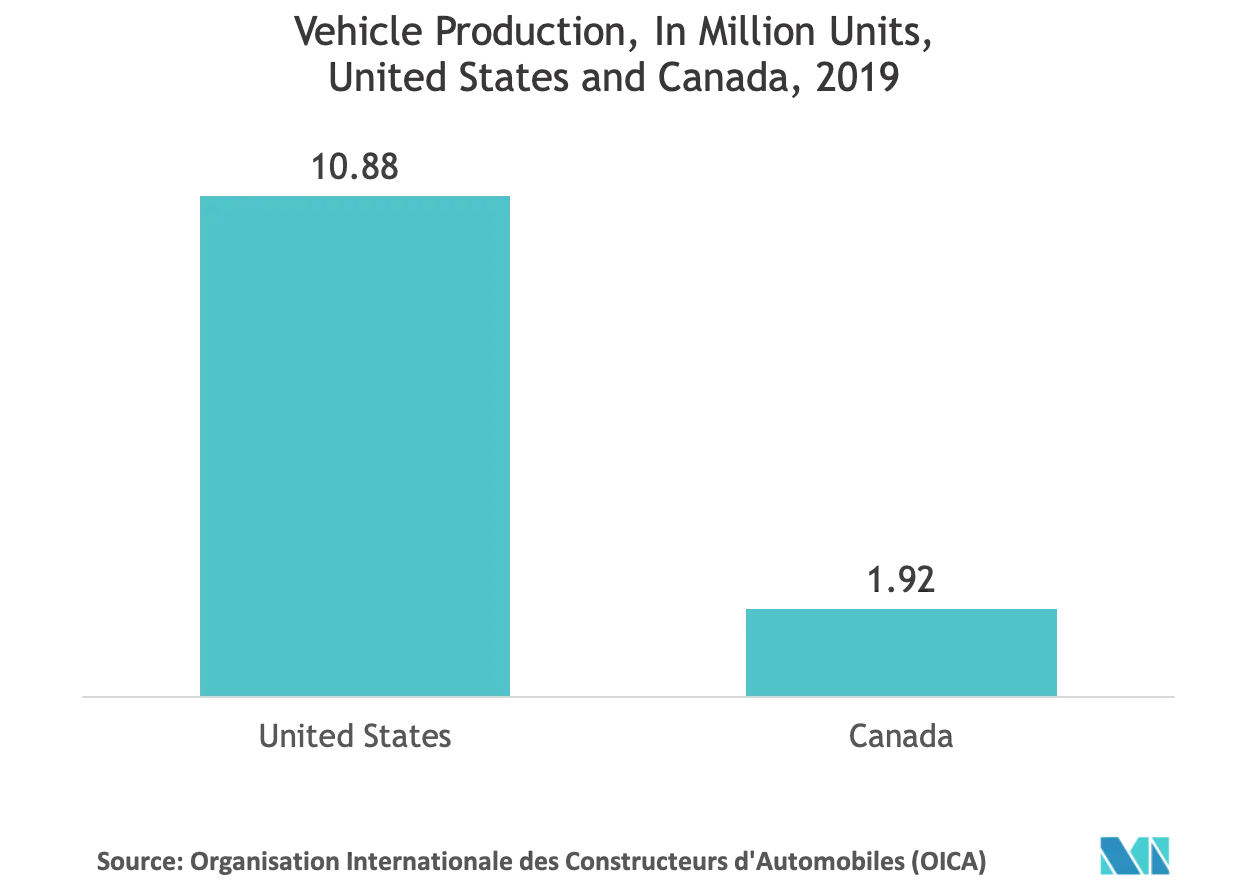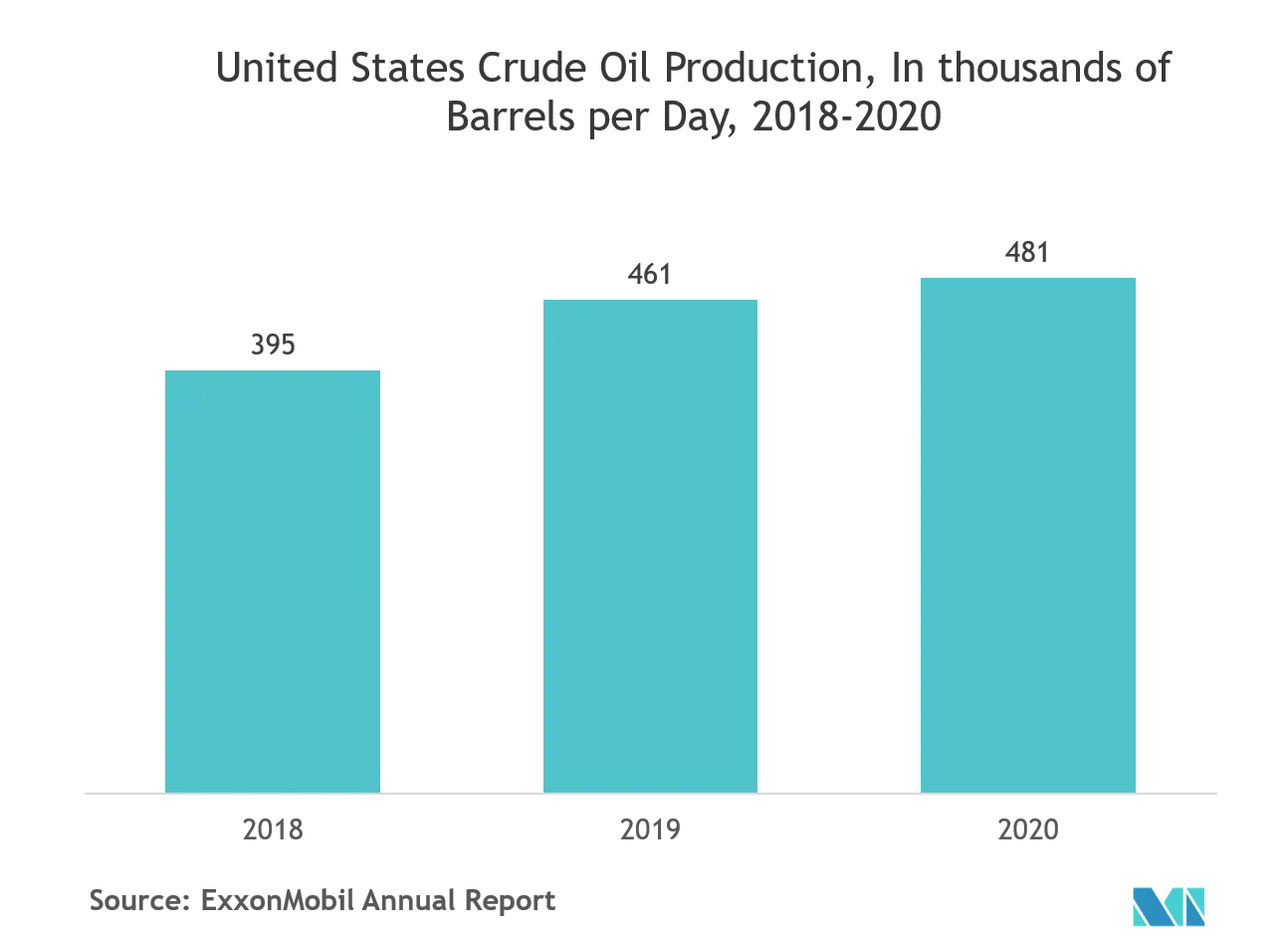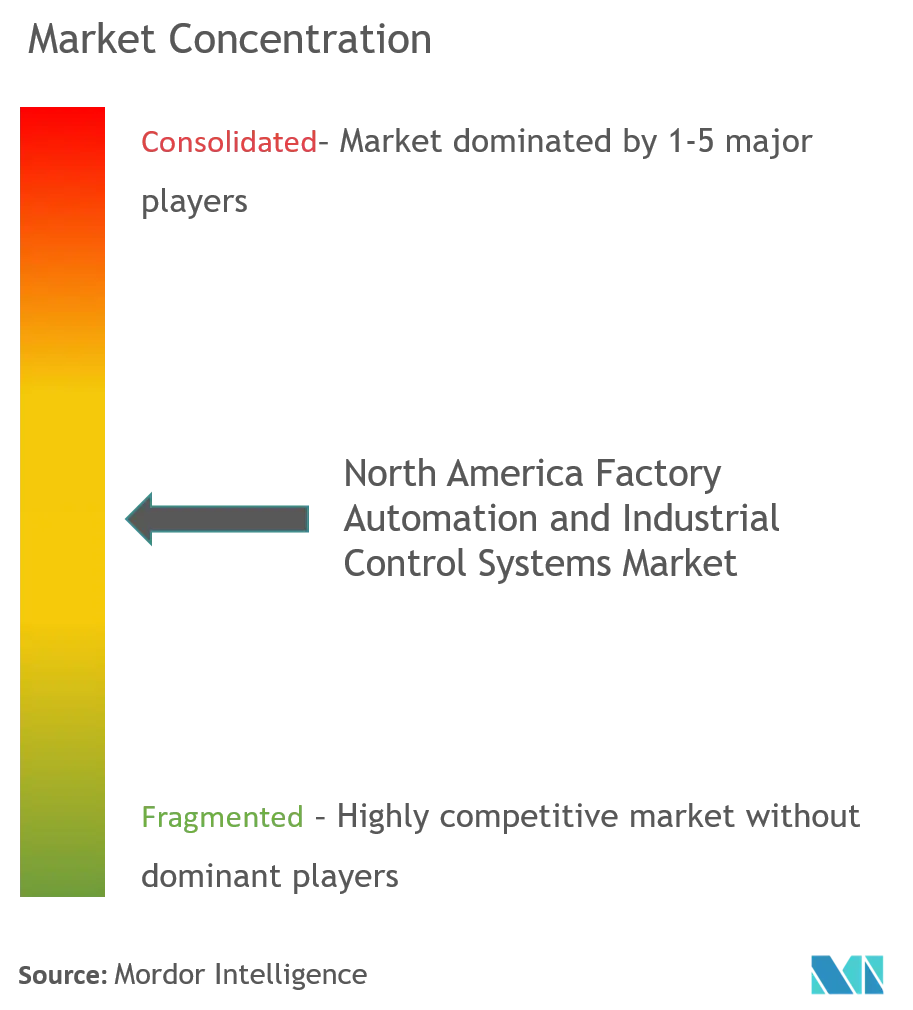North America Factory Automation and Industrial Controls Market Analysis
The North America Factory Automation and Industrial Controls Market is expected to register a CAGR of 8.12% during the forecast period.
- >
- Therefore, to save energy and to gain cost-benefit, the trend of factory automation and industrial control systems is gaining traction in the region. According to a 2019 report from Oxford Economics, the United States is projected to lose more than 1.5 million jobs to automation over the next decade.The regional automotive sector has always led the way in implementing robotics in their manufacturing processes. Key industry manufacturers, like John Deere, are making significant investments to integrate automated technology both into their products and processes.
- The region is witnessing increasing robotic technologies adoption. For instance, in March 2020, globally renowned SCARA robot manufacturer, Epson Robots, collaborated with the US-based automation solutions provider, Air Automation Engineering (AAE), as part of an initiative to increase its technical support in the Midwest United States.
- The adoption of factory automation solutions can help these manufacturers in cost savings, enhance productivity, and improve quality. Recently, Royal Bank of Canada (RBC) collaborated with Microsoft and launched the Go Digital program, mainly to help the Canadian businesses in investing in smart automation technologies and cloud solutions. Presently, the program is available to Canadian food manufacturers and will continue to expand to other industries over time.
- Initiatives, like 'Advanced Manufacturing Partnership (AMP)', are increasingly undertaken to make the regional industry, various universities, and the federal government to invest in the emerging automation technologies. The government in Canada created a program, Automate Canada, a global cluster of companies, specializing in manufacturing automation solutions. In the past, it also invested USD 230 million to help automate Ontario's manufacturing sector.
- However, establishment of new automated manufacturing plant mandates the deployment of emerging automation technologies Including SCADA, DCS, RTU, PLC, and HMI. The setting up of these manufacturing plants requires large capital investments for equipment, software, and training. Investing such a large amount is difficult for new entrants who are setting up their first plant.
North America Factory Automation and Industrial Controls Market Trends
Sensors and Transmitters Field Devices to Drive the Market Growth
- With the advancement and improvement in the processing of speed and material handling in the industrial operations, it has become important for the industries to bring similar level of efficiency improvement across the processing and handling stages. It has been an important aspect in the industry to avoid and reduce bottlenecks across the production line and beyond and has driven the demand. For instance, these offer opportunities to the automotive industry to react faster to market requirements, reduce manufacturing downtimes, enhance the efficiency of supply chains, and expand productivity.
- Proximity sensors are used in smart factory for varied applications. These sensors are becoming more important with the growing use of fast conveyer systems and automated robots. Capacitive sensors also have high sensitivity, making them a favorable choice for tasks related to relative positioning.
- Optical proximity sensors are finding an extensive use, owing to their small-size and ability to work in extreme conditions. However, their general use requires a dark room application, and they also come at a higher price point compared to other type of sensors.
- The processes involved in a smart factory are heavily dependent on the ability of machines to maintain desired rate of input and output. This ensures minimum ideal time and maximum output and avoids overcrowding. Due to these functions, the market for position and velocity sensors is expected to witness a significant growth during the study period. This industry is also projected to witness a shift toward digital systems, owing to increasing incorporation of computers for factory management.
United States Holds Significant Market Share
- The United States has traditionally been a forerunner in terms of adoption of key technological innovations. A continuation of these trends have been observed. Recently, Ford deployed cobots in its Cologne paint shop. The six cobots sand Fiesta bodies in 35 seconds, further improving the manufacturing process. Additionally, the country is home to various enterprises that are increasingly adopting automation to optimize operations.
- The US oil and gas industry has been a primary demand driver for PLC systems for automation tasks. Automation has not only enabled the high production of oil and gas in the country but also been responsible for the smooth distribution of oil products within the country. Further, Toyota Material Handling North America (TMHNA) selected two universities' research proposals to receive funding through the TMHNA University Research Program.
- Moreover, the country is one of the largest producers of crude oil and a prominent player in the oil and gas industry. For instance, according to EIA, the country produced 24.94 quadrillion Btu of Crude Oil in 2019, and by 2030, the production number is expected to reach 30.01 quadrillions Btu. Additionally, Texas (United States) produces the major share of crude oil in the country, and it is expected to hold a significant demand for production equipment.
- Most of these foreign players are adopting partnership and acquisition strategy, which is also bringing advancement at a global level. For instance, in May 2021, Empire Petroleum announced the acquisition of ExxonMobil's oil and gas assets in US to strengthen its presence in the United States. The assets comprise of about 700 oil, gas, and injector wells and accounts for 40,000 net acres of Permian leasehold, approximately.
North America Factory Automation and Industrial Controls Industry Overview
The North America factory automation and industrial controls market is competitive due to several players in the market. Players are involved in product development and strategic activities such as partnerships, mergers, and acquisitions. Some of the key developments in the market are:
- February 2021- ABB announced the expansion of its collaborative robot portfolio with the launch of its new GoFa and SWIFTI cobot families. These robots offer higher payloads and speeds, to complement YuMi and Single Arm YuMi in ABB's cobot line-up. These are designed to serve industries such as electronics, healthcare, consumer goods, logistics, food and beverage and others.
- March 2020 - Omron Corporation opened a new robotics and safety automation business headquarters in the United States. The company invested USD 10 million in the new facility, where it would design, develop, test, and manufacture robotic and safety automation solutions.
North America Factory Automation and Industrial Controls Market Leaders
-
Rockwell Automation Inc.
-
Honeywell International Inc.
-
ABB Limited
-
Siemens AG
-
Schneider Electric SE
- *Disclaimer: Major Players sorted in no particular order
North America Factory Automation and Industrial Controls Industry Segmentation
The syndicated study on factory automation and industrial controls (or industrial automation) includes both process and discrete automation. The scope is comprehensive and is limited to North America. Segments that will be covered in the study are By type (Industrial Control Devices, Field Devices), By End User (Oil and Gas, Chemical and Petrochemical, Power and Utilities, Food and Beverages, Automotive and Other End-user Industries) and By country (United States and Canada).
| By Type | Industrial Control Systems | Distributed Control System (DCS) | |
| PLC (Programmable Logic Controller) | |||
| Supervisory Control and Data Acquisition (SCADA) | |||
| Product Lifecycle Management (PLM) | |||
| Human Machine Interface (HMI) | |||
| Manufacturing Execution System (MES) | |||
| Field Devices | Machine Vision Systems | ||
| Robotics (Industrial) | |||
| Sensors and Transmitters | |||
| Motors and Drives | |||
| Other Field Devices | |||
| By End-user Industry | Oil and Gas | ||
| Chemical and Petrochemical | |||
| Power and Utilities | |||
| Food and Beverages | |||
| Automotive | |||
| Other End-user Industries | |||
| By Country | United States | ||
| Canada | |||
North America Factory Automation and Industrial Controls Market Research FAQs
What is the current North America Factory Automation and Industrial Controls Market size?
The North America Factory Automation and Industrial Controls Market is projected to register a CAGR of 8.12% during the forecast period (2025-2030)
Who are the key players in North America Factory Automation and Industrial Controls Market?
Rockwell Automation Inc. , Honeywell International Inc., ABB Limited, Siemens AG and Schneider Electric SE are the major companies operating in the North America Factory Automation and Industrial Controls Market.
What years does this North America Factory Automation and Industrial Controls Market cover?
The report covers the North America Factory Automation and Industrial Controls Market historical market size for years: 2019, 2020, 2021, 2022, 2023 and 2024. The report also forecasts the North America Factory Automation and Industrial Controls Market size for years: 2025, 2026, 2027, 2028, 2029 and 2030.
Our Best Selling Reports
North America Factory Automation & Industrial Controls Industry Report
Statistics for the 2025 North America Factory Automation and Industrial Controls market share, size and revenue growth rate, created by Mordor Intelligence™ Industry Reports. North America Factory Automation and Industrial Controls analysis includes a market forecast outlook for 2025 to 2030 and historical overview. Get a sample of this industry analysis as a free report PDF download.

